This is how the public sector works with innovation
An innovative and collaborative public sector is crucial for us to be able to address societal challenges and achieve the goals in Agenda 2030. The survey "Innovation in the public sector 2019 – 2020" takes the pace of the level of activity in public businesses. It is a follow-up to the Innovationsbarometer survey from 2018.
The survey was presented at a seminar on May 19 , read more here and take part in documentation
Meeting societal challenges – the role of the public sector
The public sector, which in this survey consists of authorities (excluding university colleges and universities), regions and municipalities, has a multidimensional role in the societal challenges we face. In part, the public sector is a framework for the private sector to relate to, for example with permit processes, rules and instructions. For private individuals, meetings are often about school, care and social care, to name a few. But the public sector also controls the demand for goods and services through public procurement and it gathers a wide range of skills within the organisations.
Innovation in the public sector is not driven by economic values but by societal factors. Constant improvement work with solutions vis-à-vis the private sector, increasing the school's opportunities to strengthen students and teachers, and integrating social issues with environmental work for increased exchange for the labor market and well-being are in focus.
The results of the survey presented here show that the work with innovation is high, but that there are large differences between regions, municipalities and the authorities' systems, their driving forces and the own results of the work.
The work with innovation was mostly financed within the regular budget, but there are extra resources from funds, state grants or other funding. The budget distribution of the own work with research and development points to the fact that the resources allocated are unevenly distributed. The regions' expenditure in 2021 for their own R&D was approximately SEK 4.6 billion, compared to the municipalities, which in this context reported expenditure of just over SEK 200 million (SCB 2022). This is a results of the fact that areas with a high research structure, such as healthcare and health, are under the auspices of the regions. The fact that the regions have a greater habit of research-related work can be a contributing factor to an increased implementation of research results and change work. The results of the survey also indicate that the regions have to a high or rather high extent access to funding for project and activities for innovation than, for example, the municipalities (see results file below).
Almost half work systematically with innovation
The possibilities for successful results from innovations increase if the work with innovation is systematic within the organization. During 2019-2020, about half of the respondents worked systematically with innovation, where the regions to a very high extent, with a share of 79 percent compared to municipalities where the share was about 36 percent.
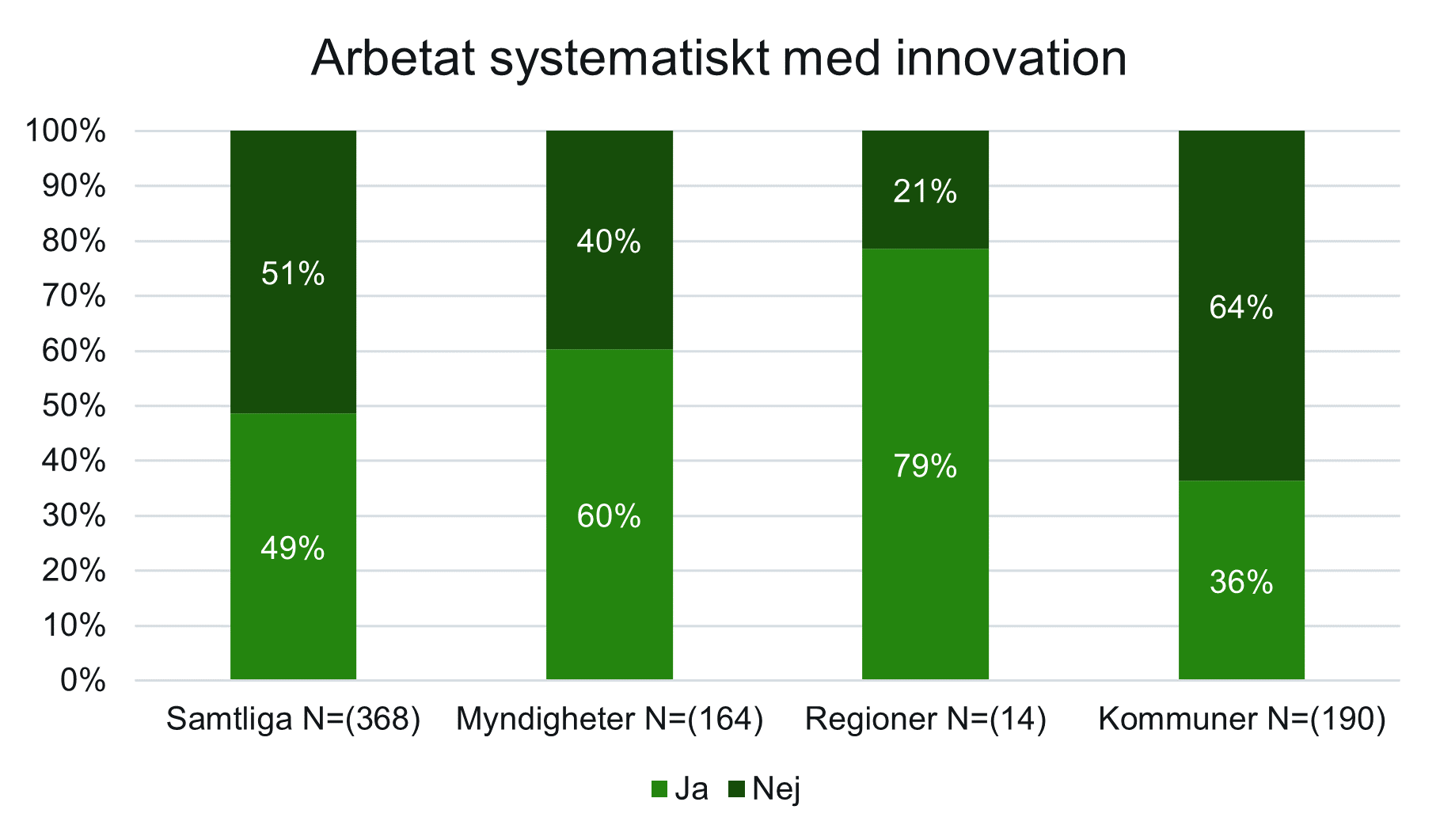
Innovation strategies not prioritized in the public sector
An innovation strategy must be an instrument to focus and guide the work forward. The results of the survey show that approximately 17 percent of the respondents have adopted an innovation strategy. This is slightly less than the 18 percent who stated that they had a strategy in 2018. The decline is mainly due to the fact that fewer authorities have a current strategy, while more municipalities and regions have strategies in place during 2019-2020 compared to 2018.
The regions stand out in that more than half state that they have an adopted innovation strategy. This is consistent with the higher percentage of respondents who work systematically with innovation. The authorities mostly state that they do not have an adopted innovation strategy, although a high percentage of respondents believe that they work systematically with innovation.
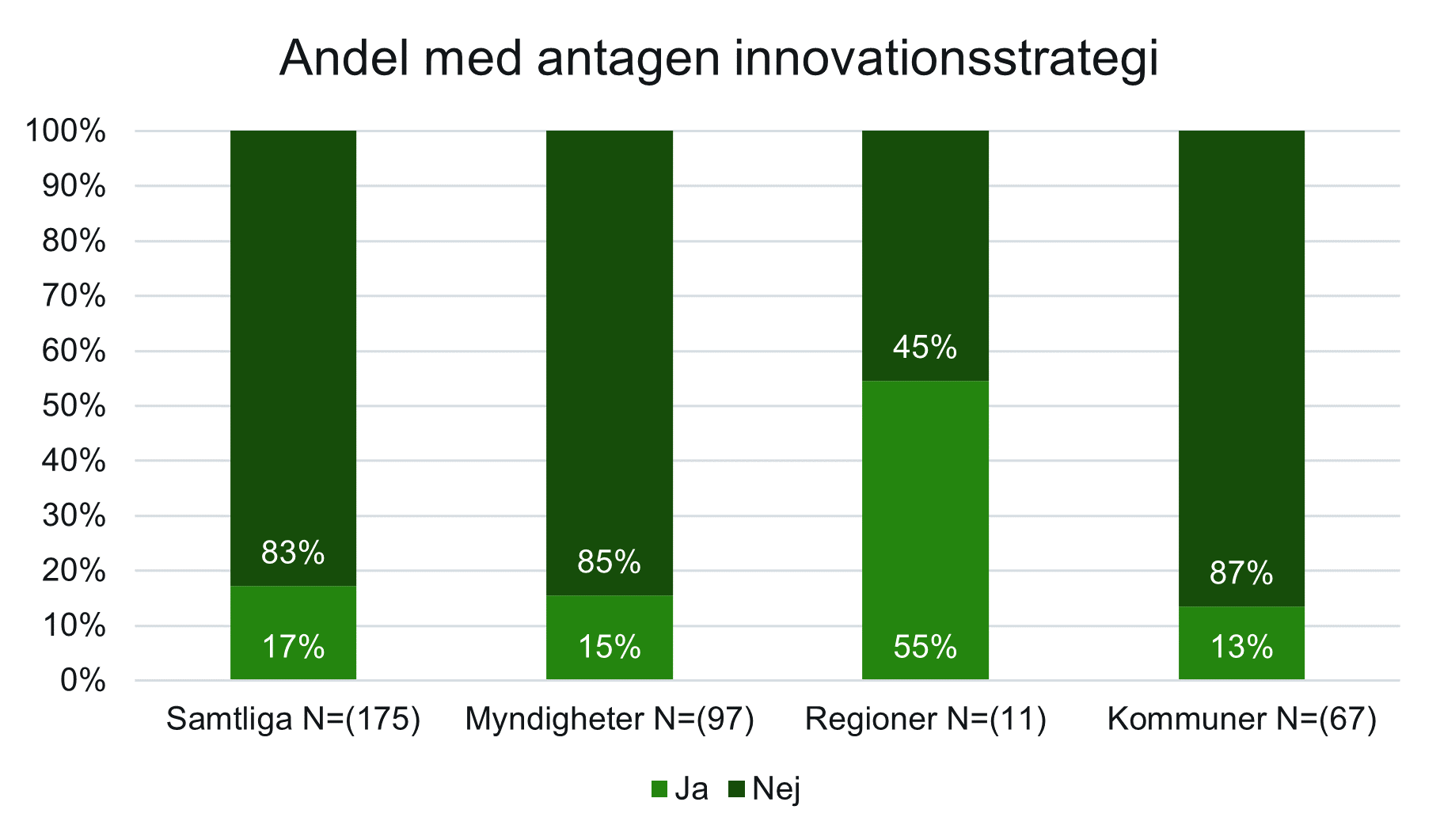
Driving forces and activities
The driving forces for the work can be interpreted as starting from both a supply and demand perspective. The innovation work of the public sector is to a high or fairly high degree a results of new technology and knowledge enabling changes in the organizations (71 percent). Additional strong driving forces are needs and expectations from users of services provided (64 percent). To an almost equal extent, the work is driven from the internal knowledge and instructions to deal with societal challenges (61 percent).
In other words, the work is a combination of several driving forces that together create demand for innovation and change in the public sector.
Interesting to note are the needs and expectations of users that were highlighted as a strong driving force. The survey cannot answer how the users' needs are captured by the public sector. However, the survey indicates that the work to develop ideas and initiatives takes place in collaboration with users or the outside world. In addition, the work takes place to a large extent in collaboration with others within the organization or other actors.
To a much lesser extent, innovation is demanded via purchases. Activities relating to intangible assets, such as patents or trademark protection, have also not been a major focus for the respondents.
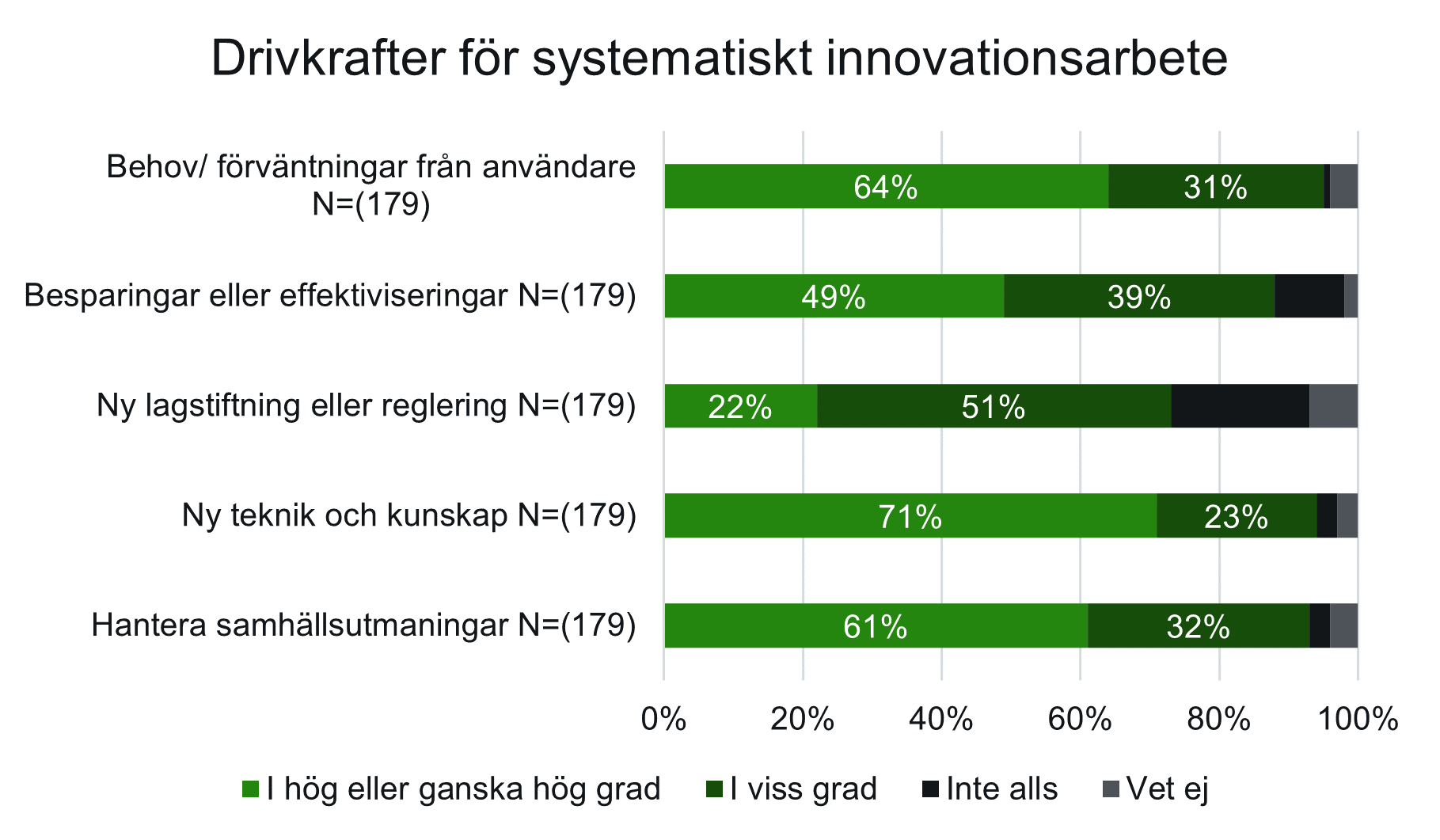
Introduction of innovation high within regions and with authorities
The survey deepened certain questions to specific workplaces to capture the introduction of innovation and its impact. Industries that were included include care, care, school and social initiatives. A few actors within the scope of agriculture, manufacturing, waste disposal and other services that are included as part of the public sector have also been included in the survey.
The results indicate that authorities and workplaces within regions introduced at least one innovation to the same extent during 2019-2020 (65 percent in regions, 64 percent in authorities). Of the responding workplaces under municipal authority, approximately 54 percent introduced at least one innovation during the years 2019-2020.
The direction of the innovations concerned both changes in processes within the business and in the range of goods or services. Municipalities and regions reported a somewhat higher introduction of product innovations, which reflects the direction of the municipal and regional companies. The authorities stated that more process-related innovations have been introduced.
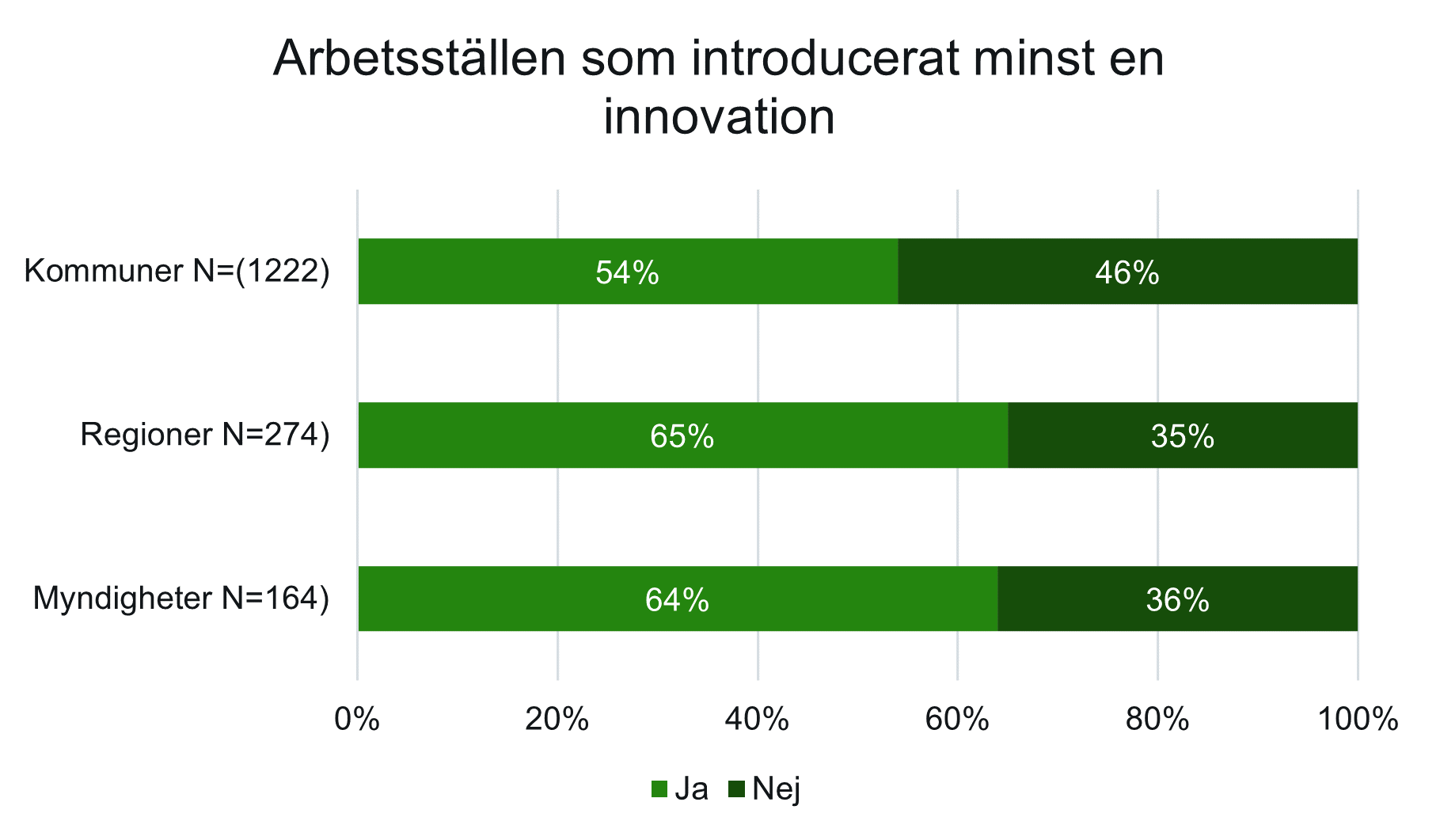
Small or big changes?
The innovations that were introduced in processes and products during 2019-2020 were in most cases small and incremental changes that were mostly identical or very similar to those previously applied by others. The learning effects are thus an important part of the work that takes place in the public sector.
Compared to the 2018 innovation barometer, the results show that gradual changes dominate the innovation work. In order for the work carried out to be seen as an innovation, however, a significant change compared to the workplace's previous processes and range of products must take place.
The results show, however, that even innovation work that caused a radical change took place. This means that the organization's offerings and working methods have changed significantly to a greater extent than the gradual change. That the different forms of change work are so clearly visible in the results also points to the fact that the public sector has the capacity and opportunities to work with the different ways of working that a change of a lower degree entails and the power that a radical change entails.
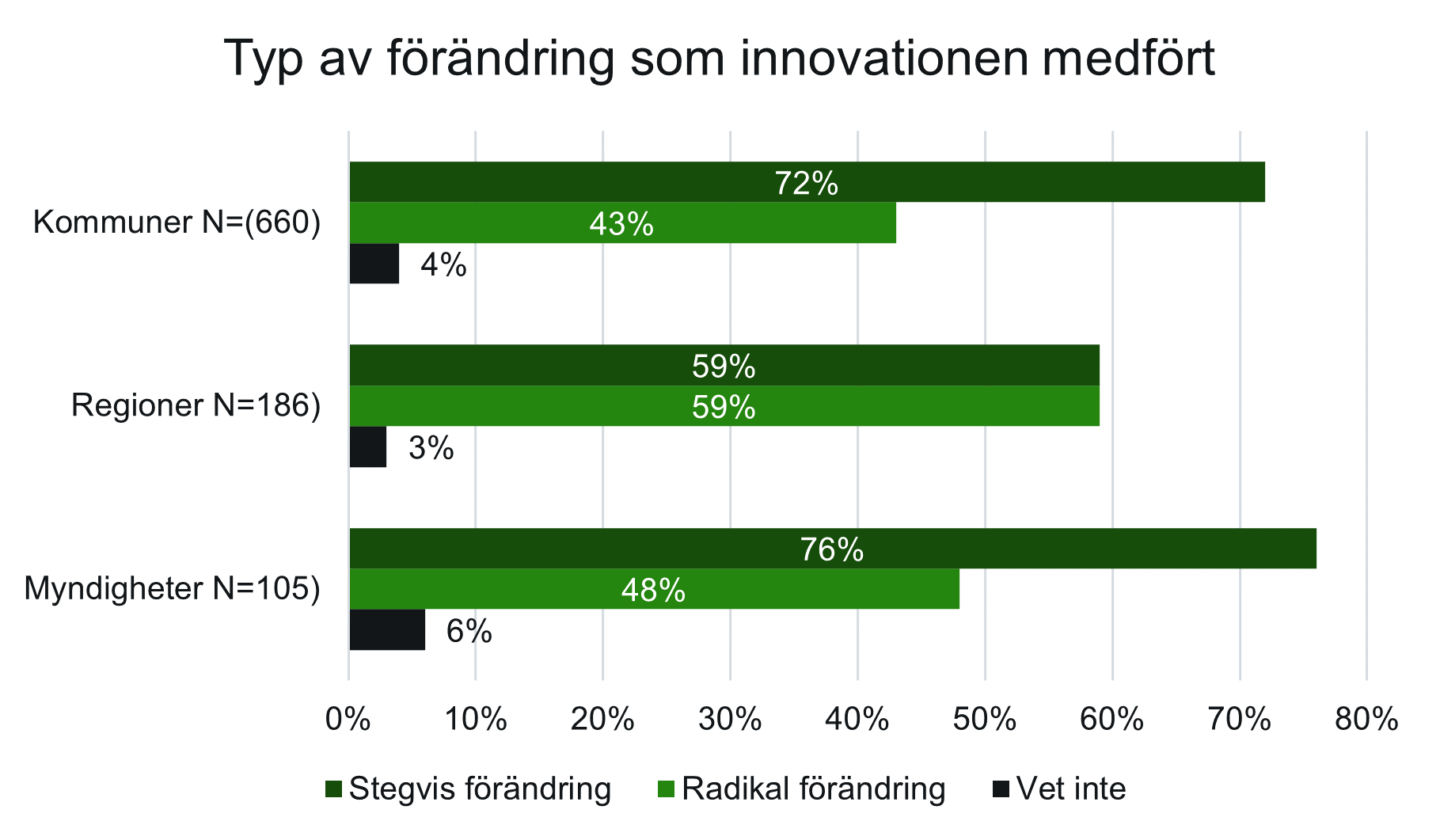
Samtliga Se all questions and answers are reported in the compilation of raw data (xls, 153 kB)
Definitions
The definitions used in the survey for innovation and innovation activity in the public sector are based on OECDs Oslomanual and SCB's survey "Innovation in the business sector".
Innovation
An innovation is a new or improved product (good or service), process or combination thereof, which is significantly different from the business's previous products or processes.
To count as an innovation, the product or process must also be made available to potential users, for example customers, residents or employees.
Innovation activities
Innovation activities refer to all types of activities an activities carries out that aims to result in innovation. They can both aim to support innovative capacity and to introduce new or improved products and processes.
- Develop ideas and initiatives from users or the outside world. For example, through suggestion boxes, brainstorming, innovation competitions, citizen dialogue, etc.
- Prepare documentation on needs and opportunities. For example, through environmental monitoring, user surveys, market dialogues, etc.
- Strengthen leadership and employees' competence for innovation
- Collaborate with others to innovate. For example with actors such as consultants, government authorities, industry associations, non-profit associations such as patient associations, suppliers etc.
- Invest in infrastructure for innovation purposes. This includes buildings, machinery, equipment and other tangible fixed assets, development or purchase of software and databases
- Design, prototype and test new or significantly improved products or processes. For example through risk/benefit analysis, feasibility studies and tests
- Demand innovation through purchasing
- Conduct research and development (R&D). R&D consists of creative and systematic work with aim of increasing the amount of knowledge and finding new applications of existing knowledge in all fields of science.
- Introduce and disseminate results of the innovation activities
- Follow up and evaluate results of innovation
- Manage intangible assets (patents, licenses, etc.)
That's how the survey was done
The survey was sent to innovation managers/municipal managers within all government agencies and all the country's municipalities and regions. The survey asked questions about strategy, driving forces and conditions for innovation (part A)
In parallel, parts of the survey were also sent to a sample consisting of approximately 5,000 workplaces in public activities. The workplaces responded to questions about actual workplace innovations and innovation activities (part B).
See all questions and answers in the compilation of raw data
Read more about the implementation and methodology behind the survey The technical measurement report.
In total, approximately 370 responses were received for part A, management level, and 1,500 responses for part B, workplace level. The response rate was good for questionnaire part A, higher than in 2018, but marginally lower than in 2018 for part B.
Response rate:
Del A
- Central level: 72% (47% in 2018)
- Government agencies: 81%
- Regions: 70%
- Municipalities: 66%
Del B Arbetsställesenkät: 29% (32% 2018)
In an analysis of the non-response, Statistics Norway states that even part B should be able to be used despite a low response rate. Read more in the dropout analysis.
The innovation barometer 2018
The "Innovation Barometer" was carried out by Sweden's municipalities and regions in collaboration with the City of Gothenburg and Mälardalsrådet and with support from Vinnova in 2018. It consisted of two surveys and was answered by approx. 1,800 respondents.
Read more about the Innovation Barometer 2018.
International equivalents
The innovation barometer was first developed in Denmark, and then other Nordic countries have carried out similar surveys of their own, as well as Holland, for example.
Results, comparisons and examples of innovations from the Nordic countries
The Copenhagen manual on what the survey can look like and go to
Questions?
Jonny Paulsson
Frida Lundmark
Adrian Solitander
Annika Bergendahl
Questions?
Last updated 6 April 2023

